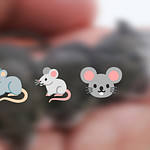
Essay about The daily life of a Neolithic man
You look around and see a landscape that seems from another world. Houses made of mud and straw, people dressed in simple animal skin clothes, domestic animals such as sheep and pigs roaming freely, and an idyllic landscape of green fields and dense forests. You are in the Neolithic, the historical period from about 10.000 years ago when people began to farm and live in settled communities.
The daily life of a Neolithic man was full of activities, and the most important of them was agriculture. Being sedentary, people had to provide food by growing plants and raising domestic animals. Every morning, the men would wake up early and head out to the surrounding fields to perform their farm duties. Women stayed in the settlements to cook, take care of the children and do other household chores.
Another important activity was stone processing. Neolithic people used stones to make tools such as the ax and axe, to help with agricultural activities and to build houses. Although these tools were crude compared to those of today, they were an important innovation for the people of that time.
In their free time, Neolithic people spent time together, especially at meals. Eating was often an important moment of socialization and community bonding. Games and dances were also a popular activity during holidays and social events.
In addition to daily activities, Neolithic people developed a rich material culture. This included pottery, jewelry and other decorative items. These were not only functional, but also represented important values and traditions for the community.
In general, the daily life of a Neolithic man was marked by work, but also by moments of socialization and culture. Despite the difficulties and limitations of that time, people have been able to build strong communities and develop important technologies and material cultures.
Although the daily life of a Neolithic man may seem primitive and devoid of technology, it was far from simple. People of that time had their own way of meeting their needs, getting food and building their houses and necessary tools.
An important aspect of the daily life of Neolithic people was agriculture. They cultivated grains such as wheat and barley and legumes such as beans and peas. This method of producing food allowed communities to become sedentary and establish permanent settlements.
Although the Neolithic was a time of the emergence of agriculture and sedentarization, people of that period continued to hunt and gather berries to supplement their diet. They also raised livestock such as goats, sheep and pigs.
In terms of building houses, Neolithic people used natural materials such as wood, stone and clay. Houses were generally built in the form of large barns with mud walls and thatched roofs. Some communities built their houses in the form of round huts, made of reeds and clay.
In addition to farming, hunting, and building houses, Neolithic people also engaged in other activities, such as leatherworking, toolmaking, and the creation of ornamental objects. This complex and varied way of life was the basis of human development and the evolution of human societies.
Presentation with the title "Daily life in the Neolithic period"
Introduction:
The Neolithic period is considered the turning point in human history, being the time when people moved from nomadism to sedentarism and developed the first permanent settlements. In this report we will explore the daily life of a Neolithic man, starting from food, housing, to occupations and religion.
Daily life in the Neolithic:
In terms of food, Neolithic people relied mainly on agriculture and animal husbandry. Cereals, such as wheat and barley, were grown to produce bread and other staple foods. Vegetables such as peas and lentils were also grown. Neolithic people domesticated animals such as pigs, sheep and goats to use as a food source.
The dwellings of Neolithic people were usually built of clay and reeds, and were round or oval in shape. Inside the house, there were areas for sleeping, cooking and storage. In general, the houses were small and could accommodate only one family.
In terms of occupations, Neolithic people were mainly engaged in agriculture and animal husbandry, but also in other trades, such as pottery, metalworking and clothing making. Neolithic people also developed a system of trade, in which goods were exchanged for other goods or for money.
Religion also played an important role in the lives of Neolithic people. Many Neolithic people had a belief in deities and the existence of an earth spirit that provided them with food and protection. Some Neolithic settlements contained temples or sanctuaries, which were used for religious rituals and ceremonies.
About the way of living and social organization
Neolithic people began to settle in one place and build permanent settlements. Their houses were built of stone and clay and were often sheltered underground. Within the community, people divided their responsibilities according to gender, with men mainly engaged in hunting and farming, while women were responsible for the household and raising children. In addition, public buildings such as temples and assembly buildings were often constructed to serve as social and religious centers.
About food mode and technologies
Neolithic humans moved from hunting and gathering to agriculture and animal husbandry. This change allowed people to settle in one place and develop their communities. The cultivation of cereals and other plants became a key activity in the Neolithic, and animals such as pigs, sheep and goats became important for food as well as milk, wool and hides. Neolithic people also developed new technologies to help them in their daily lives, such as some stone tools, such as axes and knives, and clay vessels for cooking and storing food.
On art and religion
Neolithic people created a variety of artifacts, including statues, paintings, and jewelry, that provide insight into their art and religion. Artifacts such as large female statuettes have suggested that women may have played an important role in religion and culture, and cave paintings and drawings suggest a preoccupation with animals and nature. Neolithic people also created jewelry from stone, bone, and other materials, which were used to decorate their bodies and clothing. In terms of religion, Neolithic people are believed to have had religious beliefs and practices involving animals, plants, and other aspects of nature.
About cultural development and the exchange of ideas
Neolithic people were able to develop a common culture due to their settlement in one place and the development of agriculture and animal husbandry. This allowed them to develop common technologies and cultural objects, as well as to share their knowledge and experiences.
Conclusion:
In conclusion, the daily life of a Neolithic man was one full of challenges, but also of satisfaction. People of that time had to adapt to the harsh conditions of the environment and learn to procure food and resources for survival. However, they developed ingenious technologies and methods to simplify their work and improve their lifestyle. Although they did not have access to the comforts and conveniences we have today, Neolithic people managed to build a solid society and live their lives with dignity and courage. By studying their daily lives, we can better understand the evolution of mankind and appreciate how our ancestors fought to secure a better future.
Descriptive composition about The daily life of a Neolithic man
A day in the Neolithic
It was a summer morning, the sun was barely rising over the Neolithic hills. I opened my eyes and felt a wave of gratitude that I was alive. I got up from my clay bed and went out into the yard of my house to greet my day. The fresh air greeted me with a cool breeze and I felt blessed to be here, to experience daily life in the Neolithic.
I started the day with a walk through the green fields and a wonderful view of the nature that surrounded me. In the distance, I saw a group of people from my tribe, who were preparing to set out for the river to fish and gather medicinal plants. I joined the group and was welcomed with open arms.
We walked together to the river, and when we got there, I saw that it was already full of people dividing their tasks to be as efficient as possible. Some people fished, some gathered herbs, and some gathered wild fruits and vegetables.
I started helping with the fishing and after a few hours of work we managed to catch enough fish to feed our tribe for a whole day. We also collected herbs to help heal wounds and illnesses in our tribe.
After finishing our work, we returned together to our village. While walking on the stone road, I listened to the stories of the people of my tribe about our history and traditions, which made me realize how important this community is to me.
In conclusion, my experience in the Neolithic taught me a lot about the way of life of the people of that time. I learned that respect for nature and teamwork are fundamental values for survival during that time. While experiencing this everyday life, I realized how important community is and living in harmony with nature.






